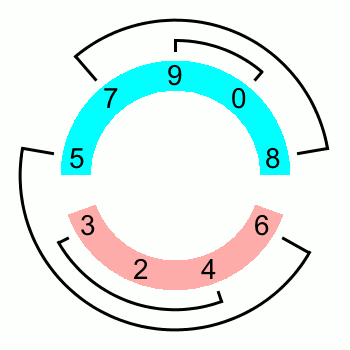





This week we finally managed to get a ten-bell band together, and we succeeded with a quarter of Fermanagh. Like many of the methods I've been advocating as a modern surprise royal repertoire, it has a clear separation between frontwork and backwork. There are also many minor and major methods with a similar separation, which I have illustrated here by putting a black line on top of the grid to show the lack of crossover between front and back.
Kent and Oxford can be considered in a similar way, with the frontwork consisting of the slow work, but they don't have exactly the same separation because the non-slow bells all reach 1st place.
When ringing a method of this kind on handbells, different leads feel very different according to whether your bells are both in the frontwork, both in the backwork, or split between the frontwork and the backwork. Not every place bell is either entirely in the frontwork or entirely in the backwork - typically some of them start or finish the lead in the backwork pattern as well as spending time on the front. But what I'm interested in here is whether a pair of bells spend any time split between the front and the back. Many ringers find that having both bells in the same region, so that they are working more closely together in the same pattern, is easier than having one bell in each region. I know, however, that some ringers prefer their bells to be separated, perhaps then finding it easier to track each bell along its line.

Regardless of whether you think the split leads are easier or more difficult, it's interesting to consider how they occur for each pair. The further apart your pair are in the coursing order, the more split leads you get during a whole course of the method. The animated diagram shows how it works for Fermanagh. The place bells are shown in coursing order around a circle. There are five place bells in the backwork (shaded in blue) and four place bells in the frontwork (shaded in pink). Each black line links two place bells rung by one of the handbell pairs: for 9-10 the place bells are adjacent in the coursing order, for 3-4 they are separated by one bell, for 7-8 they are separated by two bells and for 5-6 they are separated by three bells. In the animation, the black lines rotate according to the place bell order of Fermanagh, to show the progression of split and non-split leads.
The following table shows how many leads of each kind there are for each pair.
| Pair | Frontwork | Backwork | Split |
|---|---|---|---|
| 9-10 | 3 | 4 | 2 |
| 3-4 | 2 | 3 | 4 |
| 7-8 | 1 | 2 | 6 |
| 5-6 | 0 | 1 | 8 |
One thing I hadn't realised until we were preparing to ring Fermanagh is that when 9-10 are in a split lead, so are all the other pairs. So, if everyone finds the split leads tricky, everyone gets a tricky lead at once, making it a potential hazard when ringing.
Similar diagrams and analysis can be produced for other methods, but the details depend on how many place bells are in the frontwork and how many are in the backwork. For example, Remus (the next method on my target list) has six place bells in the frontwork and three in the backwork, so its table is different.
| Pair | Frontwork | Backwork | Split |
|---|---|---|---|
| 9-10 | 5 | 2 | 2 |
| 3-4 | 4 | 1 | 4 |
| 7-8 | 3 | 0 | 6 |
| 5-6 | 2 | 0 | 7 |